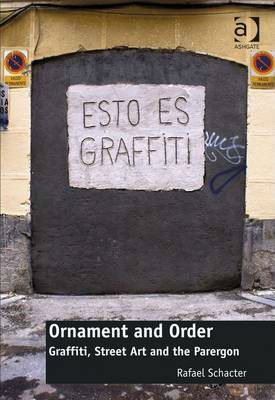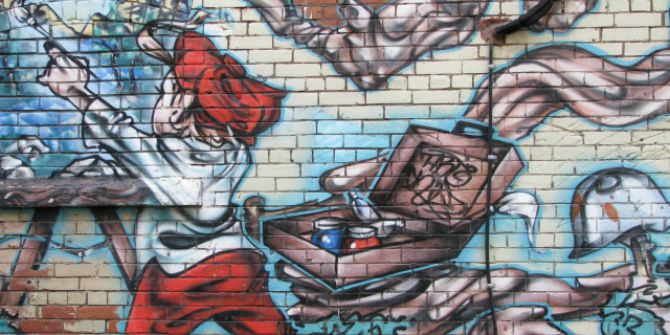Ornament and Order offers a valuable and insightful view into an underexplored area of street art, writes Kate Bailey. The majority of examples draw on Rafael Schacter’s two-year period of fieldwork based in Madrid, where he was embedded within an artistic collective. Rather than just being applicable to Madrid, the book’s variety of examples, case studies and theoretical discussions ensures this text would be useful for scholars looking at street art in numerous spaces and places.
 Ornament and Order: Graffiti, Street Art and the Parergon. Rafael Schacter. Ashgate Publishing. 2014.
Ornament and Order: Graffiti, Street Art and the Parergon. Rafael Schacter. Ashgate Publishing. 2014.
With Rafael Schacter’s book, Ornament and Order comes a new and interesting lens through which to explore street art. Graffiti, or as Schacter terms it, ‘Independent Public Art’ has been examined from a number of different angles within the academic field: the relationship between graffiti and criminality; its place within youth and gang culture; and the history of New York spray can art, to name but a few. As the foreword of the book notes, Ornament and Order does not provide a ‘definitive approach’ for studying graffiti (one could even question whether this is possible considering the multiplicity and diversity of characteristics that street art is endued with); what it does offer however, is a new perspective. Schacter’s aim with Ornament and Order was to place Independent Public Art in a broader forum that allowed it to be examined as a form of ornamentation, as a ‘ritualistic’ performance, and as an art form not solely reliant on capital for its existence; and it is clear upon reading that he has achieved this. Ornament and Order ‘deconstruct[s] more conventional dogma’ that surrounds street art and opens up the conversation surrounding this controversial art form.
The book is divided into two sections: ‘Ornament’ and ‘Order’. Schacter starts the book by examining the products of graffiti: the ‘Ornament’. By defining Independent Public Art as a form of ornamentation, Schacter carves out a place for street art “within the wider debate…over ornament in the architectural cannon as a whole”, placing it in a position where it may be examined as something “addictive rather than reductive”; the negative connotations usually associated with graffiti are replaced by an acknowledgement of the power such ornamentation can and does hold, both over the space it is placed in and the lives of those creating it. The majority of examples he uses of this ornamentation draw on his two-year period of fieldwork based in Madrid, where he was embedded within an artistic collective. Yet Schacter also refers to worldwide collectives and the work of artists based in a host of different cities, preventing the book from becoming a study of simply one situation. By including a range of case studies from various locations, Schacter’s theories and ideas concerning graffiti are demonstrated as being more widely relevant; rather than being applicable to the one physical location of Madrid, the variety of examples allows Ornament and Order to be used by scholars looking at street art in numerous spaces and places.
 Image credit: Graf Writer in a Mural by
Image credit: Graf Writer in a Mural by
Within this discussion of Independent Public Art as a form of ‘Ornament’, Schacter presents us with two subdivisions: ornament that is ‘Consensual’ and ‘Agonistic’. ‘Consensual’ ornament is defined as a form of Independent Public Art designed to work within a community and within the sense of communal opinion and agreement: it is a practice “based upon the intentions of private individuals to rally together”. ‘Agonistic’ ornament is the opposite of this: it seeks to highlight contrast and to create friction; “it is difference, fracture they [the artists] seek to display”. This distinction is used to an effective end, and permits the conversation within the book to naturally move into more theoretical discussions regarding the creation of Independent Public Art and the reasoning and intention behind it. The presence of these theoretical discussions, as with the myriad of case studies used in examples, permits the book to offer a broader scope of thought on the topic of street art and present concepts that can be applied across the academic field, since it draws on highly pertinent ideas such as the role of the spectator, legitimacy of democracy and governance, and the unity of form and function.
As Schacter rigorously explored the two definitions of ‘Consensual’ and ‘Agonistic’ ornament, the continuation of the discussion when it is being applied to the idea of ‘Order’ within street art is easy to follow and understand. This section of the book focuses on the processes of artists through which works of Independent Public Art are created. It discusses the performance that goes into creating pieces, offering insights into why the pieces are created and why, despite the dangers and lack of financial gain, artists continue to engage with it. Schacter also introduces the idea of ‘ritual’ within street art, a term that he takes time to examine and apply clearly. The earlier identification of the distinction between the two types of ornament lends itself to the introduction of this idea, as Schacter recognizes that despite the opposing views and intentions, communities of artists continue to live harmoniously beside one another. It is the ‘ritual’, a ‘sacred, yet not religious’ process, of creating street art that holds the groups together. Schacter notes himself within the text that rather than observe one physical space, he instead studied the spaces that were defined and created by the communities themselves: there were no physical boundaries as such to Schacter’s study; he worked instead within the areas defined by practice or ‘ritual’. This multi-sited aspect of Schacter’s research works in the overall favour of the book, as it highlights the importance of Schacter’s observations concerning the centrality of the ‘ritual’ of creation to the presence of artistic communities and Independent Public Art.
Despite the introduction of new terminology and definitions, Ornament and Order is a book that would be suitable for those familiar with research conducted on graffiti or for researchers beginning their explorations. Throughout the text Schacter neatly intertwines the ideas of ‘Ornament’ and ‘Order’, identifying their differences but also their co-existence and importance. He provides relevant histories concerning street art, extracts from his field notes and interviews, and an extensive bibliography. The book also contains a number of photographs in both black and white, and colour. The presence of these pictures aids Schacter’s discussion, as the reader is able to see for themselves the placement and form of the Independent Public Art, although at times, Schacter could integrate these images more into the discussion taking place in the body of the text. Schacter is thorough in his academic discussions, and what is evident throughout the book is the respect that the author has for both the artistic communities he worked with and the Independent Public Art itself. Ornament and Order offers a valuable and insightful view into an underexplored area of street art, and successfully presents it as a practice based on something more than crime or disputed aesthetic tastes.
Kate Bailey is a PhD student in the History Department at Lancaster University, UK. Her research is currently examining the memorialization of the ‘disappeared’ in Guatemala, looking at the use of street art, art exhibitions, museums, and public events as forms of alternative memorial. Follow her on Twitter here: @KH_Bailey.








1 Comments